Do you have a question about the PIAGGIO Beverly 125 and is the answer not in the manual?
Overview of main dashboard buttons, levers, and indicators.
Details of warning lights, speedometer, and ignition key positions.
Instructions for locking/unlocking the steering and operating turn signals.
Operation of the horn button and headlight switch modes.
Using start/stop buttons and understanding the anti-theft immobilizer.
Information on master key, normal keys, and the crucial code card.
How the immobilizer indicator functions and its operational states.
Step-by-step procedure to program new keys into the immobilizer system.
Accessing the fuel tank and verifying successful key programming.
Using the 12V power socket and procedures for opening the saddle.
Methods to open the saddle and locate vehicle identification numbers (VIN).
How to use the helmet hook and related safety warnings.
Essential checks before riding and safe refuelling instructions.
Adjusting the rear shock absorber spring preloading.
Recommended procedures for the first 1000 km of vehicle operation.
Step-by-step guide for starting the engine safely.
Advice on engine care, temperature, and speed limits.
Solutions for engine starting problems like flooding or fuel issues.
Procedures for engine shutdown and using centre/side stands.
Operation of the automatic transmission and clutch precautions.
Advice for safe riding, including braking and road surface considerations.
Warnings on riding under influence, modifications, and accessory impact.
Checking and adding engine oil for proper lubrication.
Interpreting oil warning light and oil/filter replacement procedures.
Procedure for checking and maintaining the rear hub oil level.
Importance of correct tyre pressure and checking wear indicators.
Steps for accessing, removing, and refitting the spark plug.
How to service the air filter element.
Cleaning schedule for SAS filters on different engine types.
Checking coolant and its scheduled replacement interval.
Inspecting brake fluid levels in handlebar reservoirs.
Adding brake fluid and its replacement schedule.
Locating the battery and key maintenance points.
Maintaining battery health during periods of inactivity.
Identifying fuse locations and their role in protecting circuits.
Table listing types, power, and quantities for all vehicle bulbs.
Procedure for replacing front headlight bulbs.
Adjusting headlight aim and replacing turn signal bulbs.
Procedure for replacing the license plate light bulb.
Replacing helmet light bulb and setting engine idle speed.
Details on disc brake wear compensation and lever stroke.
Emergency tyre repair and the importance of wheel balancing.
Guidelines for long-term storage and vehicle cleaning.
Common engine starting, ignition, and compression problems.
Addressing issues with performance, brakes, suspension, and transmission.
Identifying and resolving exhaust noise issues.
Engine specifications for both 125cc and 250cc models.
General dimensions, fuel capacity, and exhaust system details.
Technical details on braking, suspension, and transmission systems.
Chassis construction, weight, load, and fluid volumes.
List of tools provided with the vehicle and their storage.
Safety advice regarding spare parts, accessories, and loads.
Speed restrictions with accessories and precautions for anti-theft devices.
Introduction to periodic maintenance operations and their importance.
Details of scheduled maintenance for the 125cc model at various mileage points.
Details of scheduled maintenance for the 250cc model at various mileage points.
Overview of main dashboard buttons, levers, and indicators.
Details of warning lights, speedometer, and ignition key positions.
Instructions for locking/unlocking the steering and operating turn signals.
Operation of the horn button and headlight switch modes.
Using start/stop buttons and understanding the anti-theft immobilizer.
Information on master key, normal keys, and the crucial code card.
How the immobilizer indicator functions and its operational states.
Step-by-step procedure to program new keys into the immobilizer system.
Accessing the fuel tank and verifying successful key programming.
Using the 12V power socket and procedures for opening the saddle.
Methods to open the saddle and locate vehicle identification numbers (VIN).
How to use the helmet hook and related safety warnings.
Essential checks before riding and safe refuelling instructions.
Adjusting the rear shock absorber spring preloading.
Recommended procedures for the first 1000 km of vehicle operation.
Step-by-step guide for starting the engine safely.
Advice on engine care, temperature, and speed limits.
Solutions for engine starting problems like flooding or fuel issues.
Procedures for engine shutdown and using centre/side stands.
Operation of the automatic transmission and clutch precautions.
Advice for safe riding, including braking and road surface considerations.
Warnings on riding under influence, modifications, and accessory impact.
Checking and adding engine oil for proper lubrication.
Interpreting oil warning light and oil/filter replacement procedures.
Procedure for checking and maintaining the rear hub oil level.
Importance of correct tyre pressure and checking wear indicators.
Steps for accessing, removing, and refitting the spark plug.
How to service the air filter element.
Cleaning schedule for SAS filters on different engine types.
Checking coolant and its scheduled replacement interval.
Inspecting brake fluid levels in handlebar reservoirs.
Adding brake fluid and its replacement schedule.
Locating the battery and key maintenance points.
Maintaining battery health during periods of inactivity.
Identifying fuse locations and their role in protecting circuits.
Table listing types, power, and quantities for all vehicle bulbs.
Procedure for replacing front headlight bulbs.
Adjusting headlight aim and replacing turn signal bulbs.
Procedure for replacing the license plate light bulb.
Replacing helmet light bulb and setting engine idle speed.
Details on disc brake wear compensation and lever stroke.
Emergency tyre repair and the importance of wheel balancing.
Guidelines for long-term storage and vehicle cleaning.
Common engine starting, ignition, and compression problems.
Addressing issues with performance, brakes, suspension, and transmission.
Identifying and resolving exhaust noise issues.
Engine specifications for both 125cc and 250cc models.
General dimensions, fuel capacity, and exhaust system details.
Technical details on braking, suspension, and transmission systems.
Chassis construction, weight, load, and fluid volumes.
List of tools provided with the vehicle and their storage.
Safety advice regarding spare parts, accessories, and loads.
Speed restrictions with accessories and precautions for anti-theft devices.
Introduction to periodic maintenance operations and their importance.
Details of scheduled maintenance for the 125cc model at various mileage points.
Details of scheduled maintenance for the 250cc model at various mileage points.
| Engine Type | Single-cylinder, 4-stroke |
|---|---|
| Displacement | 124 cc |
| Cooling System | Liquid cooled |
| Fuel System | Electronic fuel injection |
| Transmission | Automatic CVT |
| Front Suspension | Hydraulic telescopic fork |
| Seat Height | 790 mm |
| Front Tire | 110/70 - 16 |
| Rear Tire | 140/70 - 14 |
| Rear Suspension | Dual shock absorbers |
| Front Brake | Disc |
| Rear Brake | Disc |
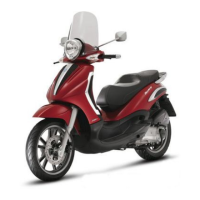
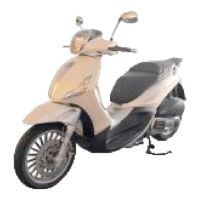
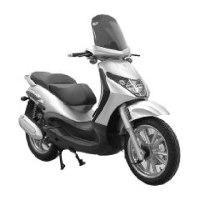

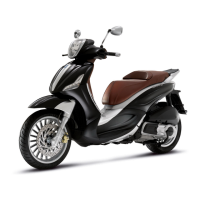
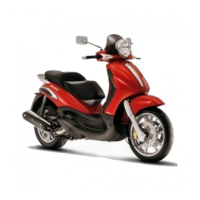
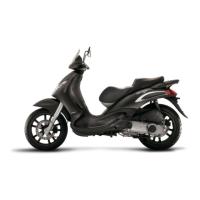


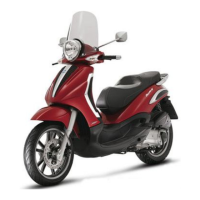
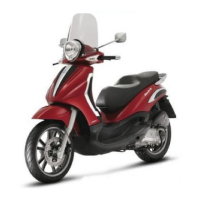
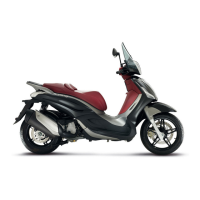
